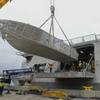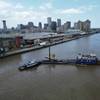Five Minutes with Bill Clifford, President, BAE Systems Ship Repair
We recently spent some time with Bill Clifford, President, BAE Systems Ship Repair, to discuss his views
How did you come to your current position?
Clifford I currently serve as the president of BAE Systems Ship Repair and have been in this position since 2008. In this role, I lead our six full service shipyards and our 5,000 highly skilled employees. Prior to assuming my current role, I was the vice president and general manager of BAE Systems Norfolk Ship Repair. Before joining BAE Systems, I spent more than 20 years in the private sector serving in senior management positions at several shipyards. From 2001 to 2005, I was a managing partner of Pacific Shipyards International, LLC, a Hawaii consortium of Honolulu Shipyard, Inc. and Honolulu Marine, Inc. I was also the vice president of new construction at Atlantic Marine in Jacksonville, Florida and Director of Ship Completion at Bath Iron Works.
Before I joined the private sector, I served on active duty in the U.S. Navy for 20 years, including tours on the USS Wallace L. Lind, the USS Ault, the USS Fairfax County and the USS Papago, where I was the commanding officer. My final tour on active duty was Commanding Officer of a 700 person Shore Intermediate Facility in Hawaii. I am a 1969 graduate of the U.S. Naval Academy and earned my master’s degree in mechanical engineering from the Navy’s Postgraduate School in Monterey, California.
How would you describe your management style?
Clifford My team would probably use one of my favorite quotes to describe my management style, “It’s Friday and you know what that means; only two more work days!” I am a firm believer that hard work pays off. Shipyards are a 24/7 hands-on operation so it is definitely a come in early and stay late type of job; it is a full contact team sport!
Give to me the “Executive Overview” of BAE Systems’ ship repair capabilities?
Clifford Headquartered in Norfolk, Virginia, BAE Systems Ship Repair is a leading non-nuclear ship repair, modernization, overhaul and new construction company in the United States. BAE Systems Ship Repair services the U.S. Navy and other defense agencies, such as Military Sealift Command, the Maritime Administration, the U.S Army and the U.S. Coast Guard. Ship Repair's commercial market includes tankers, cargo ships and cruise ships representing Disney, Carnival, Holland-America and Royal Caribbean cruise lines and highly capable small ship construction facilities in Jacksonville, Florida and Mobile, Alabama.
Our strategic acquisition, in 2008, of the Mobile and Jacksonville shipyards was the fulfillment of our plan to expand into the commercial maintenance and repair business. Additionally, this acquisition gives us significant new construction capabilities for the offshore oil and gas and Jones Act transportation markets, which help balance our business portfolio. We have more than 5,000 highly-skilled employees working at our full-service shipyards and worksites strategically located in Norfolk, VA; Jacksonville/Mayport, FL; Mobile, AL; San Diego and San Francisco, CA; and Pearl Harbor, Hawaii.
When you look at the expanse of your operations, what do you count as the primary strength of your company?
Clifford The primary strength of BAE Systems Ship Repair is without question our highly skilled workforce. Our employees and their commitment, energy and ‘can do’ attitude are what make us successful. In addition to our expert workforce, the “main batteries” of our business are the capital investment in piers, drydocks and cranes of our shipyards. You have to have these facilities, well maintained and safe to work on ships!
Please provide some insights on your business mix, specifically how much is commercial vs. military/government? Also, is the current ratios, in your mind, the optimal or desired mix, and how do you see this changing?
Clifford Our business mix is heavily weighted to the military/government sector but, as we move forward we want to continue to grow our commercial maintenance and repair, module fabrication and new construction portfolio.
BAE Systems has been a prime driver in the consolidation of ship repair business in the U.S. What was the impetus for this expansion?
Clifford Our goal has always been to have capabilities and facilities wherever the customer is located. As we have grown, our customer base has grown as well. Our primary customer is the U.S. Navy and we are expanding to encompass the commercial market as well. Our current locations allow us the ability to share skilled workforce, lessons learned and efficiencies across the entire BAE Systems Ship Repair enterprise for both the military/government and commercial customer bases in the GoM.
These are some tough economic and budgetary times: How has the recent economic slump and budget cutting in Washington affected your business?
Clifford Budget cuts in Washington, especially those to the Navy, are always of great concern to our business. The U.S. Navy is our biggest customer and when their budget comes under fire, there is always the threat of decreased workload in our shipyards due to these budget cuts. The slowdown in permitting and drilling activity in the Gulf of Mexico has also impacted our business plans.
What do you consider the biggest challenge in running an efficient, profitable ship repair business today?
Clifford The biggest challenge is maintaining a stable volume of work to support your core skilled workforce and managing the surges through partners, subcontractors and reliable temporary labor. Additionally, the sluggish economy affects all business and ours is certainly no different. We have to remain vigilant and seek opportunities where ever they exist. We have some exciting business prospects that we hope come to fruition in the future.
In the face of cheaper overseas alternatives, what do you count as the biggest challenge to running a U.S.-based ship repair business today?
Clifford U.S. shipyards provide high quality repairs and service to our customers in a very competitive market. The U.S. operates in a free market global economy, which means that we have to compete with countries that have heavily subsidized their shipyards. In order to remain a player in our line of business, U.S. ship repair companies have to find innovative ways to remain competitive. The Jones Act is an important government regulation that is critical to the ship repair and construction industry as the GoM and off shore wind markets resurge.
Over your career, what do you consider to be the leading technologies or developments that have most positively impacted the business of repairing ships?
Clifford We have worked closely with the Navy to develop innovative and efficient processes to weld aluminum structures with extremely high quality. Also, computer aided design and fabrication tools that enable extremely accurate cutting, welding and the assembly of very complex steel and aluminum structures.
How is BAE Systems investing today?
Clifford We invest heavily in workforce development through several programs. Aside from safety, the next most important aspect of our business is the critical influx of young skilled workers who can learn the trades from our current, aging employees. When our craftspeople retire, they take decades of valuable experience with them. If we can continue to attract young people who are eager to learn, they can get unparalleled experience in the trade of their choice via the opportunity to work alongside some of the most qualified artisans in their trades.
What do you count as the most interesting or challenging ship repair job you or your company has ever been involved?
Clifford I think the first ever Aegis modernization of the guided missile cruiser USS BUNKER HILL (CG 52) in San Diego Ship Repair a few years back meets the standards of being both very interesting and very challenging. BUNKER HILL was essentially the test platform for the Navy’s Aegis modernization program. It was our responsibility to get the job done right so that the program could continue — as it does to this day — on the remaining cruisers and now it has begun on the early hulls of the Arleigh Burke Aegis guided missile destroyers. Since this was the first job of this type that any of our shipyards had done, it came with countless unexpected twists during the year that it took to complete. Fortunately, our employees did what they do best and they executed a highly successful availability, from which we still use the lessons learned today on modernization jobs to streamline the process that delivers a better product to our customers.
(As published in the May 2012 edition of Maritime Reporter & Engineering News - http://www.digitalwavepublishing.com/pubs/nwm/maritimereporter/201205)












